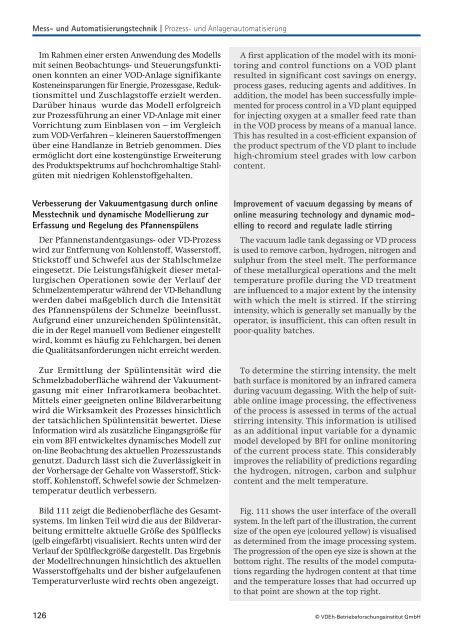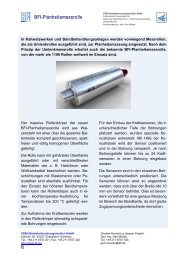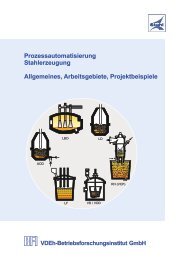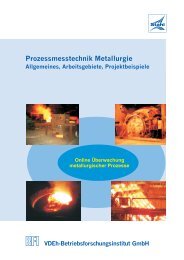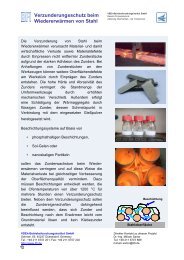Tätigkeitsbericht /Activity Report 2011/2012 - BFI.de
Tätigkeitsbericht /Activity Report 2011/2012 - BFI.de
Tätigkeitsbericht /Activity Report 2011/2012 - BFI.de
Erfolgreiche ePaper selbst erstellen
Machen Sie aus Ihren PDF Publikationen ein blätterbares Flipbook mit unserer einzigartigen Google optimierten e-Paper Software.
Mess- und Automatisierungstechnik | Prozess- und Anlagenautomatisierung<br />
Im Rahmen einer ersten Anwendung <strong>de</strong>s Mo<strong>de</strong>lls<br />
mit seinen Beobachtungs- und Steuerungsfunktionen<br />
konnten an einer VOD-Anlage signifikante<br />
Kosteneinsparungen für Energie, Prozessgase, Reduktionsmittel<br />
und Zuschlagstoffe erzielt wer<strong>de</strong>n.<br />
Darüber hinaus wur<strong>de</strong> das Mo<strong>de</strong>ll erfolgreich<br />
zur Prozessführung an einer VD-Anlage mit einer<br />
Vorrichtung zum Einblasen von – im Vergleich<br />
zum VOD-Verfahren – kleineren Sauerstoffmengen<br />
über eine Handlanze in Betrieb genommen. Dies<br />
ermöglicht dort eine kostengünstige Erweiterung<br />
<strong>de</strong>s Produktspektrums auf hochchromhaltige Stahlgüten<br />
mit niedrigen Kohlenstoffgehalten.<br />
A first application of the mo<strong>de</strong>l with its monitoring<br />
and control functions on a VOD plant<br />
resulted in significant cost savings on energy,<br />
process gases, reducing agents and additives. In<br />
addition, the mo<strong>de</strong>l has been successfully implemented<br />
for process control in a VD plant equipped<br />
for injecting oxygen at a smaller feed rate than<br />
in the VOD process by means of a manual lance.<br />
This has resulted in a cost-efficient expansion of<br />
the product spectrum of the VD plant to inclu<strong>de</strong><br />
high-chromium steel gra<strong>de</strong>s with low carbon<br />
content.<br />
Verbesserung <strong>de</strong>r Vakuumentgasung durch online<br />
Messtechnik und dynamische Mo<strong>de</strong>llierung zur<br />
Erfassung und Regelung <strong>de</strong>s Pfannenspülens<br />
Der Pfannenstan<strong>de</strong>ntgasungs- o<strong>de</strong>r VD-Prozess<br />
wird zur Entfernung von Kohlenstoff, Wasserstoff,<br />
Stickstoff und Schwefel aus <strong>de</strong>r Stahlschmelze<br />
eingesetzt. Die Leistungsfähigkeit dieser metallurgischen<br />
Operationen sowie <strong>de</strong>r Verlauf <strong>de</strong>r<br />
Schmelzentemperatur während <strong>de</strong>r VD-Behandlung<br />
wer<strong>de</strong>n dabei maßgeblich durch die Intensität<br />
<strong>de</strong>s Pfannenspülens <strong>de</strong>r Schmelze beeinflusst.<br />
Aufgrund einer unzureichen<strong>de</strong>n Spülintensität,<br />
die in <strong>de</strong>r Regel manuell vom Bediener eingestellt<br />
wird, kommt es häufig zu Fehlchargen, bei <strong>de</strong>nen<br />
die Qualitätsanfor<strong>de</strong>rungen nicht erreicht wer<strong>de</strong>n.<br />
Zur Ermittlung <strong>de</strong>r Spülintensität wird die<br />
Schmelzbadoberfläche während <strong>de</strong>r Vakuumentgasung<br />
mit einer Infrarotkamera beobachtet.<br />
Mittels einer geeigneten online Bildverarbeitung<br />
wird die Wirksamkeit <strong>de</strong>s Prozesses hinsichtlich<br />
<strong>de</strong>r tatsächlichen Spülintensität bewertet. Diese<br />
Information wird als zusätzliche Eingangsgröße für<br />
ein vom <strong>BFI</strong> entwickeltes dynamisches Mo<strong>de</strong>ll zur<br />
on-line Beobachtung <strong>de</strong>s aktuellen Prozesszustands<br />
genutzt. Dadurch lässt sich die Zuverlässigkeit in<br />
<strong>de</strong>r Vorhersage <strong>de</strong>r Gehalte von Wasserstoff, Stickstoff,<br />
Kohlenstoff, Schwefel sowie <strong>de</strong>r Schmelzentemperatur<br />
<strong>de</strong>utlich verbessern.<br />
Bild 111 zeigt die Bedienoberfläche <strong>de</strong>s Gesamtsystems.<br />
Im linken Teil wird die aus <strong>de</strong>r Bildverarbeitung<br />
ermittelte aktuelle Größe <strong>de</strong>s Spülflecks<br />
(gelb eingefärbt) visualisiert. Rechts unten wird <strong>de</strong>r<br />
Verlauf <strong>de</strong>r Spülfleckgröße dargestellt. Das Ergebnis<br />
<strong>de</strong>r Mo<strong>de</strong>llrechnungen hinsichtlich <strong>de</strong>s aktuellen<br />
Wasserstoffgehalts und <strong>de</strong>r bisher aufgelaufenen<br />
Temperaturverluste wird rechts oben angezeigt.<br />
Improvement of vacuum <strong>de</strong>gassing by means of<br />
online measuring technology and dynamic mo<strong>de</strong>lling<br />
to record and regulate ladle stirring<br />
The vacuum ladle tank <strong>de</strong>gassing or VD process<br />
is used to remove carbon, hydrogen, nitrogen and<br />
sulphur from the steel melt. The performance<br />
of these metallurgical operations and the melt<br />
temperature profile during the VD treatment<br />
are influenced to a major extent by the intensity<br />
with which the melt is stirred. If the stirring<br />
intensity, which is generally set manually by the<br />
operator, is insufficient, this can often result in<br />
poor-quality batches.<br />
To <strong>de</strong>termine the stirring intensity, the melt<br />
bath surface is monitored by an infrared camera<br />
during vacuum <strong>de</strong>gassing. With the help of suitable<br />
online image processing, the effectiveness<br />
of the process is assessed in terms of the actual<br />
stirring intensity. This information is utilised<br />
as an additional input variable for a dynamic<br />
mo<strong>de</strong>l <strong>de</strong>veloped by <strong>BFI</strong> for online monitoring<br />
of the current process state. This consi<strong>de</strong>rably<br />
improves the reliability of predictions regarding<br />
the hydrogen, nitrogen, carbon and sulphur<br />
content and the melt temperature.<br />
Fig. 111 shows the user interface of the overall<br />
system. In the left part of the illustration, the current<br />
size of the open eye (coloured yellow) is visualised<br />
as <strong>de</strong>termined from the image processing system.<br />
The progression of the open eye size is shown at the<br />
bottom right. The results of the mo<strong>de</strong>l computations<br />
regarding the hydrogen content at that time<br />
and the temperature losses that had occurred up<br />
to that point are shown at the top right.<br />
126 © VDEh-Betriebsforschungsinstitut GmbH


